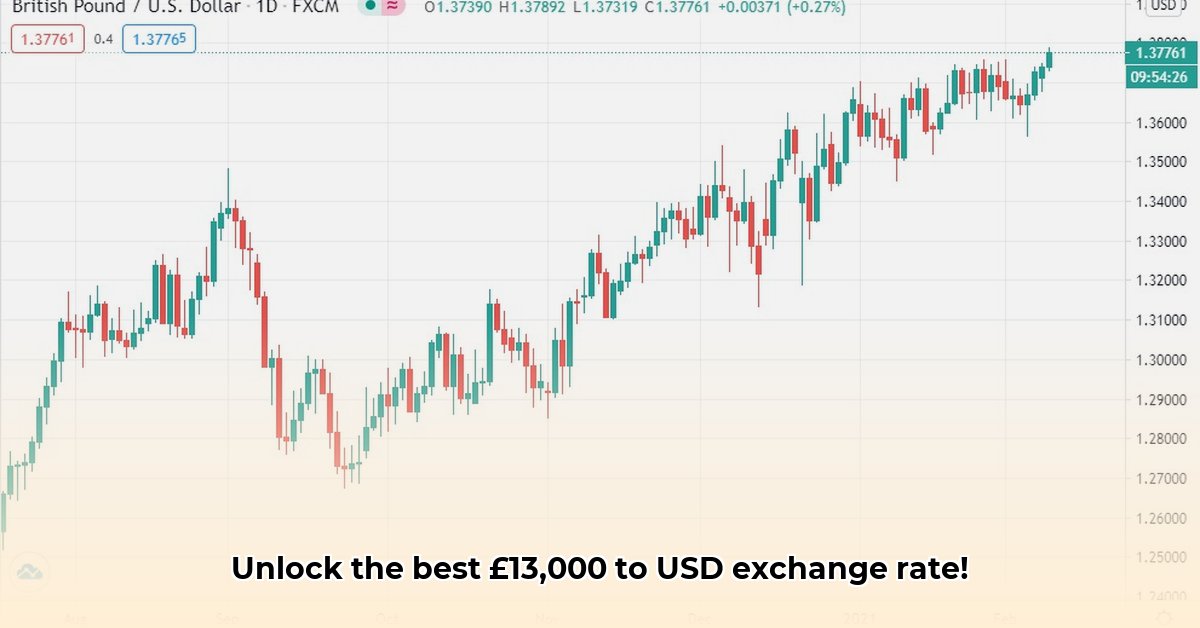
Need to convert £13,000 to US dollars? This comprehensive guide reveals how to secure the best exchange rates and avoid hidden fees, ensuring you get the most for your money. Whether you're making a large purchase, investing abroad, or simply sending money internationally, understanding the intricacies of currency conversion is crucial. For smaller conversions, check out this helpful resource on Yen to USD conversion.
Understanding GBP to USD Conversion: Rates and Fees
The GBP/USD exchange rate fluctuates constantly, impacting how much you receive for your £13,000. While the mid-market rate (the theoretical average) serves as a benchmark, providers rarely offer it directly due to fees and markups. These hidden costs can significantly decrease your final amount. This guide provides actionable steps to maximize your return. Are you aware of the potential pitfalls involved in choosing a conversion service? Many providers hide fees within opaque fee structures, leaving you unaware of the total cost.
Decoding Exchange Rate Volatility
The GBP/USD exchange rate exhibits considerable volatility. Daily fluctuations can significantly impact the final USD amount you receive. For example, a 1% shift in the rate on £13,000 translates to a £130 difference. Understanding this volatility is key to making informed decisions. Choosing the right time to convert your money can make a significant difference.
The Mid-Market Rate: A Benchmark for Comparison
The mid-market rate represents the fairest exchange rate between the pound and the dollar. It's the rate you would ideally receive, representing the average price offered in the international currency market. However, most providers add fees and markups to this rate. This markup is where the hidden costs come in. Always compare providers' offered rates to the mid-market rate to gauge the fairness and transparency of their fees.
Choosing the Right GBP to USD Converter: A Comparative Analysis
Several services facilitate GBP to USD conversions. Each operates with different fee structures and levels of transparency. To make an informed choice, let's compare two prominent providers: Wise and XE. Remember that transparency is key when entrusting your money to a financial service. Would you prefer a service that clearly outlines all fees or one that might have hidden costs?
| Provider | Fee Transparency | Fee Structure Clarity | Overall Transparency | Exchange Rate Competitiveness | Transfer Speed | Customer Support |
|---|---|---|---|---|---|---|
| Wise | High (clearly stated fees) | High (easy-to-understand breakdown) | High | High (often close to mid-market) | Relatively Fast | Excellent (multiple channels) |
| XE | Low (fees may be less apparent) | Low (requires careful review) | Low | Moderate (potential for higher markups) | Varies | Average |
Wise, for instance, is known for its upfront fee structure, while XE may require more detailed investigation to uncover all associated costs. Always check the total cost before finalizing any transaction.
Step-by-Step Guide: Converting £13,000 to USD
The conversion process is straightforward, but careful planning is critical, especially when dealing with a large amount like £13,000. Follow these five simple steps to ensure an efficient and cost-effective conversion.
- Research and Compare: Begin by thoroughly researching various money transfer services. Compare exchange rates, fees, and transfer speeds. This initial investigation is critical for making an informed decision.
- Select a Transparent Provider: Choose a provider with a transparent fee structure and favorable exchange rates. Wise is often cited for its clarity and competitive rates.
- Provide Accurate Details: Carefully enter the amount (£13,000), recipient's US bank details, and your payment information. Ensure all details are correct to avoid delays.
- Review and Confirm: Before finalizing the transfer, meticulously review all aspects: exchange rate, fees, and the total amount received in USD.
- Track and Monitor: Most services provide online tracking facilities, enabling you to monitor your transfer's progress.
Avoiding Hidden Fees and Other Potential Problems
Hidden fees are the biggest pitfall in currency conversion. These charges are often embedded within the exchange rate, making it difficult to identify the true cost upfront. To mitigate this risk, always scrutinize the fine print carefully, ensuring full disclosure of all fees. A lack of transparency should serve as a warning sign; consider using a different service.
Long-Term Considerations: Exchange Rate Trends and Regulations
Long-term trends and the changing regulatory landscape should inform your decision. While predicting short-term exchange rate fluctuations is difficult, monitoring long-term trends might help you time your conversion more favorably. Understanding the regulatory environment, where transparency and consumer protection are increasingly emphasized, is also essential. Furthermore, understanding long-term economic shifts and global events can also influence your currency conversion strategy.